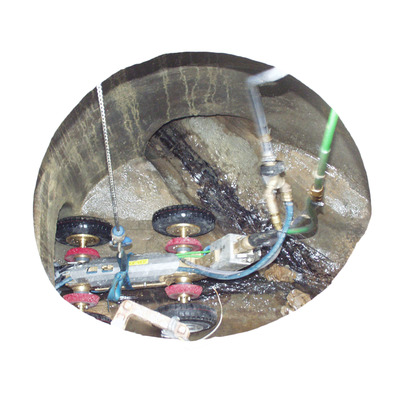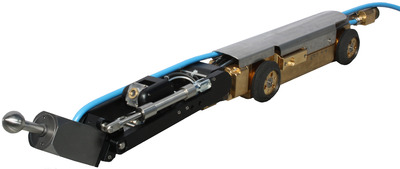Modern sewer rehabilitation concepts: no mess and no roadworks
Thursday, 07 February, 2013
Traffic is flowing on the roads without interruption. The column of cars moves forward, motorcycles putter along, heavy goods vehicles rumble their way through - just like always. Yet underneath the road surface something is happening. Almost unnoticed by road users, the sewers and drains are being rehabilitated. With no sign of a road digger! Torn up roads are a thing of the past. Modern sewer rehabilitation concepts have done away with the need for several days of roadworks, along with the stress for digger operators and impatient motorists. No mess, no jams and no potholes in the road.
Today’s sewer maintenance tools are special cameras and milling robots. Günter Meister, managing director of BRM GmbH in Biebergemünd, explains what actually goes on in the darkness of the sewer pipes: “The manhole cover is the doorway into this underworld. First, the maintenance operatives lower a special camera trolley into the pipe. Using this camera they carry out a visual inspection of the sewer pipes. The camera head - our own design - can be swivelled 270° horizontally and 400° radially. This ensures that the specialists are able to inspect the pipe walls in minute detail, and determine any damage.”

Once the initial inspection has taken place, the milling robot starts its work. Small and compact, it nevertheless uses its gigantic power to munch its way through the underground drainage network. The rotating milling head, with its diamond-studded surface, simply devours ingrown tree roots, broken-off pipe splinters and hardened, encrusted muck, thus removing any blockages in the pipes. The milling robot consists of a two-axle trolley to move the robot forward and back inside the pipe. Two hydraulic cylinders are fitted to the trolley and these tip the milling arm up and down or forward and back. The control electronics are also fitted to the trolley. A flange-mounted circle gear turns the milling arm. The air motor is carried on the milling arm itself. This motor supplies the power for the milling work and causes the milling head to rotate. At the command console the operator manipulates joysticks and switches to control the milling robot. The special camera fitted to the milling arm monitors the work underground and transmits the images to a monitor. It means that the specialists are constantly able to monitor the progress of the cleaning work.
Specialist BRM GmbH supplies two different sizes of milling robot - the F130 for DN150 to DN300 pipe widths and the F170 for DN200 to DN600 pipes. The large milling robot is now available with even more power: As an extension to the range, the firm, together with air motor manufacturer Deprag Schulz GmbH u. Co, has now developed and brought to market a new air motor for the F170, delivering twice the power. Application technician Sven Menzel at sewer maintenance company GM-San UG has tested the ‘new’ robot and has gained some early experience of working with it in sewer maintenance work. He is enthusiastic: “The output is unrivalled compared to the previous drive. On a project with 35 branch pipes, in other words inlets and outlets on the sewer pipe, we previously required 1050 working minutes to carry out the job. With this new air motor we had completed the work after just 525 minutes. That is an enormous saving in time and operating costs.”
What kind of air motor is this that is able to supply maximum output under the extreme conditions it encounters inside a dirty sewer pipe? BRM has fitted a Deprag air vane motor from the Individual Line onto the milling arm of the robot. This indestructible power pack does not give up even in the most adverse conditions. BRM’s Meister explains: “For the new, large milling robot we carried out intensive tests on various air motors from different manufacturers. In a direct comparison of power output, the Deprag air motor came out way ahead. No other air power drive achieved such high removal rates!” The air motor, which has been specifically developed for use in the milling robot, has a square housing, which is optimally adapted to the milling arm. The power pack is just 145 millimetres long and 70 millimetres wide. The drive is suitable for deployment in the tiniest of spaces. It occupies just a third of the size and has a fifth of the mass of a comparable electric motor.
Air vane motors operate on a very simple principle: The compressed air - generated by a compressor - causes the air motor to rotate. In the case of the air vane motor, the process is as follows: The rotor, which rotates inside an eccentric cylinder, is set into motion. Vanes are inserted into the slots of the rotor and the centrifugal force that arises presses them outwards. This creates work chambers for the expanding compressed air. With this expansion the compressed air that feeds through converts the pressure energy into kinetic energy - causing rotational motion. Air motors can operate optimally within a wide range of changing loads, because the power output remains almost constant over a wide speed range. Motor power is adjusted by changing the operating pressure; the speed is controlled by smoothly throttling the air quantity.

The air motor can cope with work loads up to standstill speed. Meister continued: “If the milling head encounters what appears to be an indestructible obstacle and comes to a standstill, it suffers no damage. In the event of overload the air motor simply stops, and once the load abates it starts up again immediately. And this can happen over and over again even for extended operating cycles. In short, it is the ideal drive for our milling robots. This air motor cannot overload and suffer damage.”
Menzel added: “Under the extreme conditions inside the sewer pipe, operating efficiency is very high.” To counter the adverse conditions of wet, aggressive contamination inside the sewer pipe this pneumatic drive is coated with an anticorrosion protective coating. And there is another point in favour of the air motor: Before the milling robot descends into the sewer system, the air motor is charged with compressed air. It means that moisture and contaminating particles simply cannot penetrate into the internal overpressure of the unit, since the air motor more or less ‘seals’ itself.
Let us return to the sewer rehabilitation work beneath the road surface. Once the milling robot has cleared the pipes of muck and ingrowing tree roots, the work can then continue. Defective sections of pipe are lined from inside with prepared special film tubes called inliners, thus sealing them from any potential leaks. So the pipes are not replaced, but are refurbished underground. It’s not just the pipe itself that is sealed; at first the inlets and outlets to the sewer are also sealed up. So the milling robot needs to deployed a second time: a ball-head is used to ensure that the inlets and outlets are now properly reopened. “Then the sewer system is as good as new,” emphasised Menzel. And he stressed: “With the F170 and the new Deprag air motor, the work involved in opening the branch-outs is much faster.”
Since 1989, BRM has been creating innovative solutions for drain and sewer regeneration and rehabilitation. BRM has developed a special patented camera to inspect the drainage system. The camera can also be used to show and inspect the pipe walls vertically to the axis of the sewer in an upright, accurate-to-side image. In 1994, for reasons of quality, they set up an in-house mechanical engineering division so that they could manufacture the mechanical components for the special camera, as well as the regeneration tools. In 1997, the first milling robot to handle DN200 to DN600 pipes was built for a customer. This was followed two years later by a smaller robot for DN150 to DN300 pipes. The system electronics division was set up in 2001 and in 2003 a new company head office building was constructed in Biebergemünd. The first milling robot developed in-house and equipped with special miniature hydraulics came onto the market in 2010. The range was extended with the addition of a smaller robot in the middle of 2011.
The recent expansion to the range of milling robots is a further step towards establishing a good future for this medium-sized company.
Researchers trial magnetic resin to remove PFAS
A magnetic resin invented at The University of Queensland will be trialled at wastewater...
A sustainable approach to increase wastewater recycling
Flinders University research is investigating improved effluent treatment and biosolids removal...
Inverell upgrades 30-year-old aeration system
The project entailed building a new tank at the Inverell Sewage Treatment Plant, to allow...







